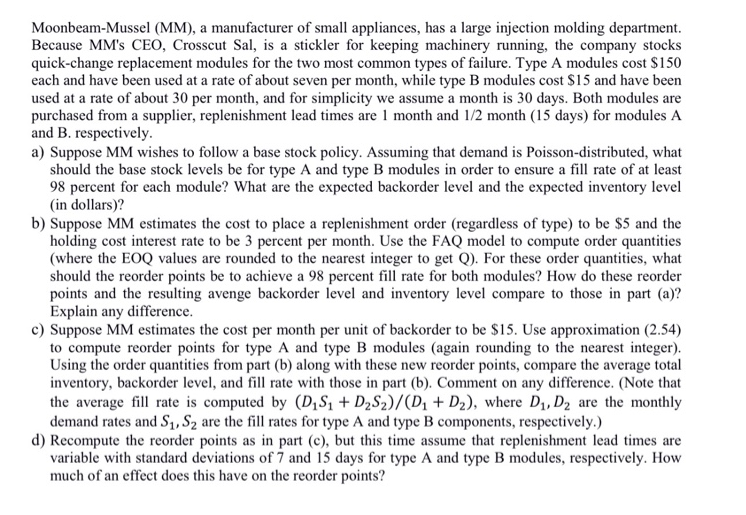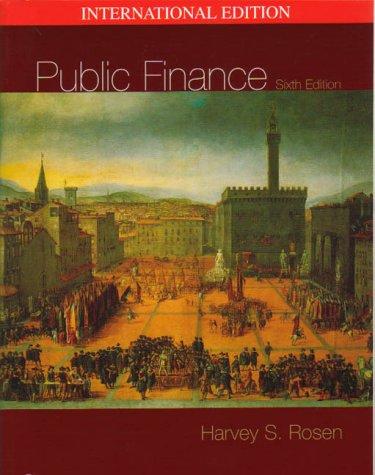Urgent: Inventory Model. Operation Research
Please solve step by step. (Chegg.com already has an answer posted but it seems wrong, so please do not copy paste and repost). Thanks again for your help.
Moonbeam-Mussel (MM), a manufacturer of small appliances, has a large injection molding department. Because MM's CEO, Crosscut Sal, is a stickler for keeping machinery running, the company stocks quick-change replacement modules for the two most common types of failure. Type A modules cost $150 each and have been used at a rate of about seven per month, while type B modules cost $15 and have been used at a rate of about 30 per month, and for simplicity we assume a month is 30 days. Both modules are purchased from a supplier, replenishment lead times are 1 month and 1/2 month (15 days) for modules A and B. respectively. a) Suppose MM wishes to follow a base stock policy. Assuming that demand is Poisson-distributed, what should the base stock levels be for type A and type B modules in order to ensure a fill rate of at least 98 percent for each module? What are the expected backorder level and the expected inventory level (in dollars)? b) Suppose MM estimates the cost to place a replenishment order (regardless of type) to be $5 and the holding cost interest rate to be 3 percent per month. Use the FAQ model to compute order quantities (where the EOQ values are rounded to the nearest integer to get Q). For these order quantities, what should the reorder points be to achieve a 98 percent fill rate for both modules? How do these reorder points and the resulting avenge backorder level and inventory level compare to those in part (a)? Explain any difference. c) Suppose MM estimates the cost per month per unit of backorder to be $15. Use approximation (2.54) to compute reorder points for type A and type B modules (again rounding to the nearest integer). Using the order quantities from part (b) along with these new reorder points, compare the average total inventory, backorder level, and fill rate with those in part (b). Comment on any difference. (Note that the average fill rate is computed by (D S1 + D2S2)/(D + D2), where D1, D2 are the monthly demand rates and S1, S2 are the fill rates for type A and type B components, respectively.) d) Recompute the reorder points as in part (c), but this time assume that replenishment lead times are variable with standard deviations of 7 and 15 days for type A and type B modules, respectively. How much of an effect does this have on the reorder points? Moonbeam-Mussel (MM), a manufacturer of small appliances, has a large injection molding department. Because MM's CEO, Crosscut Sal, is a stickler for keeping machinery running, the company stocks quick-change replacement modules for the two most common types of failure. Type A modules cost $150 each and have been used at a rate of about seven per month, while type B modules cost $15 and have been used at a rate of about 30 per month, and for simplicity we assume a month is 30 days. Both modules are purchased from a supplier, replenishment lead times are 1 month and 1/2 month (15 days) for modules A and B. respectively. a) Suppose MM wishes to follow a base stock policy. Assuming that demand is Poisson-distributed, what should the base stock levels be for type A and type B modules in order to ensure a fill rate of at least 98 percent for each module? What are the expected backorder level and the expected inventory level (in dollars)? b) Suppose MM estimates the cost to place a replenishment order (regardless of type) to be $5 and the holding cost interest rate to be 3 percent per month. Use the FAQ model to compute order quantities (where the EOQ values are rounded to the nearest integer to get Q). For these order quantities, what should the reorder points be to achieve a 98 percent fill rate for both modules? How do these reorder points and the resulting avenge backorder level and inventory level compare to those in part (a)? Explain any difference. c) Suppose MM estimates the cost per month per unit of backorder to be $15. Use approximation (2.54) to compute reorder points for type A and type B modules (again rounding to the nearest integer). Using the order quantities from part (b) along with these new reorder points, compare the average total inventory, backorder level, and fill rate with those in part (b). Comment on any difference. (Note that the average fill rate is computed by (D S1 + D2S2)/(D + D2), where D1, D2 are the monthly demand rates and S1, S2 are the fill rates for type A and type B components, respectively.) d) Recompute the reorder points as in part (c), but this time assume that replenishment lead times are variable with standard deviations of 7 and 15 days for type A and type B modules, respectively. How much of an effect does this have on the reorder points







